Experimental and Numerical Calculation Study on the Slope Stability of the Yellow River Floodplain from Wantan Town to Liuyuankou
Abstract
:1. Introduction
2. Materials and Methods
2.1. Study Area
2.2. Field Investigation
2.3. Laboratory Tests and Soil Types
2.4. The Scouring Experiment
2.5. Numerical Simulation
3. Results
3.1. Field Investigation and Geotechnical Test Results
3.2. Scouring Experiment Result
3.2.1. Failure Pattern
3.2.2. Variation of Scour Width and Height
3.2.3. Variation of Earth Pressure
3.3. Numerical Results
3.3.1. Establishing the Slope Model
3.3.2. Validation of the Bank Failure Pattern
3.3.3. Validation of the Influence of Scour Width on the Bank Stability
4. Discussion
5. Conclusions
Author Contributions
Funding
Institutional Review Board Statement
Informed Consent Statement
Data Availability Statement
Conflicts of Interest
Appendix A

| Section Name | Latitude and Longitude | Sampling Depth (cm) |
|---|---|---|
| Wantantown Yangqiaovillage Heigangkou Nie zhuang Liuyunkou | 113°56′41.08621″ 34°52′52.67728″ | 25, 63, 86, 113 |
| 113°52′4.84872″ 34°51′54.74157″ | 13, 31, 58, 61, 123 | |
| 114°15′28.19616″ 34°53′42.83452″ | 28, 58, 65, 131 | |
| 114°16′0.72747″ 34°53′46.44162″ | 13, 39, 56, 113 | |
| 114°23′26.90973″ 34°54′34.64414″ | 16, 68, 85, 140 |
| Experimental Equipment | Style | Equipment Role | Range of Parameter Variation |
|---|---|---|---|
| S-shaped flume | welded with the 1.5 mm thick iron sheet | Simulating the erosion process of the different banks | — |
| Flow meter | Electromagnetic flowmeter | Controlling water flow | 0.5–1.2 L/s |
| Static strain tester | DH3818Y | Processing of earth pressure data | −4.0–5.0 pa |
| Earth pressure boxes | Vibrating string earth pressure box | Measuring the change in earth pressure during the experiment | — |
| Cameras | Sony Alpha7C | Capturing the slope failure process | — |
| Water baffle | Granite plate | Controlling the water level height by changing its position | — |
| Graduated scale | Steel rule | Measuring the digital height | 5–10 cm |
References
- Xiang, M.; Li, Y.; Yang, J.; Lei, K.; Li, Y.; Li, F.; Zheng, D.; Fang, X.; Cao, Y. Heavy metal contamination risk assessment and correlation analysis of heavy metal contents in soil and crops. Envion. Pollut. 2021, 278, 116911. [Google Scholar] [CrossRef] [PubMed]
- Li, Z.-H.; Li, Z.-P.; Tang, X.; Hou, W.-H.; Li, P. Distribution and Risk Assessment of Toxic Pollutants in Surface Water of the Lower Yellow River, China. Water 2021, 13, 1582. [Google Scholar] [CrossRef]
- Leuven, R.; Wijnhoven, S.; Kooistra, L.; Nooij, R.; Huibregts, M. Toxicological constraints for rehabilitation of riverine habitats: A case study for metal contamination of floodplain soils along the Rhine. Large River 2005, 155, 657–676. [Google Scholar] [CrossRef]
- Bai, J.; Xiao, R.; Cui, B.; Zhang, K.; Wang, Q.; Liu, X.; Gao, H.; Huang, L. Assessment of heavy metal pollution in wetland soils from the young and old reclaimed regions in the Pearl River Estuary. South China. Environ. Pollut. 2011, 159, 817–824. [Google Scholar] [CrossRef]
- Schipper, A.; Lotterman, K.; Leuven, R.; Ragas, A.; Kroon, H.; Hendriks, A. Plant communities in relation to flooding and soil contamination in a lowland Rhine River floodplain. Environ. Pollut. 2011, 159, 182–189. [Google Scholar] [CrossRef]
- Bai, J.; Jia, J.; Zhang, G.; Zhao, Q.; Lu, Q.; Cui, B.; Liu, X. Spatial and temporal dynamics of heavy metal pollution and source identification in sediment cores from the short-term flooding riparian wetlands in a Chinese delta. Environ. Pollut. 2016, 219, 379–388. [Google Scholar] [CrossRef] [Green Version]
- Le Gall, M.; Ayrault, S.; Evrard, O.; Laceby, J.; Gateuille, D.; Lefèvre, I.; Mouchel, J.M.; Meybeck, M. Investigating the metal contamination of sediment transported by the 2016 Seine River flood (Paris, France). Environ. Pollut. 2018, 240, 125–139. [Google Scholar] [CrossRef]
- Zhao, M.; Wang, S.; Chen, Y.; Wu, J.; Xue, L.; Fan, T. Pollution status of the Yellow River tributaries in middle and lower reaches. Sci. Total Environ. 2020, 722, 137861. [Google Scholar] [CrossRef]
- Walling, D.; Owens, P.; Carter, J.; Leeks, G.; Lewis, S.; Meharg, A.; Wright, J. Storage of sediment-associated nutrients and contaminants in river channel and floodplain systems. Appl. Geochem. 2003, 18, 195–220. [Google Scholar] [CrossRef]
- Zhang, P.; Qin, C.; Hong, X.; Kang, G.; Qin, M.; Yang, D.; Pang, B.; Li, Y.; Dick, R. Risk assessment and source analysis of soil heavy metal pollution from lower reaches of Yellow River irrigation in China. Sci. Total Environ. 2018, 633, 1136–1147. [Google Scholar] [CrossRef]
- Duan, H.; MA, J.; Peng, C.; Liu, D.; Wang, Y.; Li, X.; Ma, J. Characteristics and sources of soil heavy metal pollution in cultural parks of the lower Yellow River based on APCS-MLR and PMF models. Environ. Sci. 2022, 43, 2467–2475. [Google Scholar]
- Cui, J.; Zhu, M.; Liang, Y.; Qin, G.; Li, J.; Liu, Y. Land Use/Land Cover Change and Their Driving Factors in the Yellow River Basin of Shandong Province Based on Google Earth Engine from 2000 to 2020. ISPRS Int. J. Geo-Inf. 2022, 11, 163. [Google Scholar] [CrossRef]
- Yellow River Conservanoy Commission of the Ministry of Water Resources. Yellow River Water Resources Bulletin; Yellow River Conservanoy Commission of the Ministry of Water Resources: Zhengzhou, China, 2021; pp. 32–33.
- He, G.S.; Yao, S.M.; Jin, Z.W. Research on the atypical scour of the beach on the curved convex bank of the Jingjiang reach of the Yangtze River. People’s Yangtze River 2011, 42, 4. (In Chinese) [Google Scholar]
- Wang, Y.; Xia, J.; Deng, S.; Zhou, M.; Wang, Z.; Xu, X. Numerical simulation of bank erosion and accretion in a braided reach of the Lower Yellow river. Catena 2022, 217, 106456. [Google Scholar] [CrossRef]
- Cheng, Y.; Xia, J.; Zhou, M.; Deng, S.; Li, D.; Li, Z.; Wan, Z. Recent variation in channel erosion efficiency of the Lower Yellow river with different channel patterns. J. Hydrol. 2022, 610, 127962. [Google Scholar] [CrossRef]
- Chu, Z. The dramatic changes and anthropogenic causes of erosion and deposition in the lower Yellow (Huanghe) River since 1952. Geomorphology 2014, 216, 171–179. [Google Scholar] [CrossRef]
- Yang, H.; Shi, C.; Cao, J. A Field Investigation on Gully Erosion and Implications for Changes in Sediment Delivery Processes in Some Tributaries of the Upper Yellow River in China. ISPRS Int. J. Geo-Inf. 2022, 11, 288. [Google Scholar] [CrossRef]
- Valentin, C.; Poesen, J.; Li, Y. Gully erosion: Impacts, factors and control. Catena 2005, 63, 132–153. [Google Scholar] [CrossRef]
- Prosdocimi, M.; Cerdà, A.; Tarolli, P. Soil water erosion on Mediterranean vineyards: A review. Catena 2016, 141, 1–21. [Google Scholar] [CrossRef]
- Das, V.; Roy, S.; Barman, K.; Debnath, K.; Chaudhuri, S.; Mazumder, B. Investigations on undercutting processes of cohesive river bank. Eng. Geol. 2019, 252, 110–124. [Google Scholar] [CrossRef]
- Das, V.; Roy, S.; Barman, K.; Chaudhuri, S.; Debnath, K. Study of clay–sand network structures and its effect on river bank erosion: An experimental approach. Environ. Earth Sci. 2019, 78, 591. [Google Scholar] [CrossRef]
- Julian, J.; Torres, R. Hydraulic erosion of cohesive riverbanks. Geomorphology 2006, 76, 193–206. [Google Scholar] [CrossRef]
- Yu, M.; Wei, H.; Wu, S. Experimental study on the bank erosion and interaction with near-bank bed evolution due to fluvial hydraulic force. Int. J. Sediment Res. 2015, 30, 81–89. [Google Scholar] [CrossRef]
- Keawsawasvong, S.; Ukritchon, B. Undrained limiting pressure behind soil gaps in contiguous pile walls. Comput. Geotech. 2017, 83, 152–158. [Google Scholar] [CrossRef]
- Keawsawasvong, S. Undrained stability of a spherical cavity in cohesive soils using finite element limit analysis. J. Rock Mech. Geotech. Eng. 2019, 11, 12. [Google Scholar] [CrossRef]
- Qian, Z.; Li, A.; Merifield, R.; Lyamin, A. Slope Stability Charts for Two-Layered Purely Cohesive Soils Based on Finite-Element Limit Analysis Methods. Int. J. Geomech. 2015, 15, 06014022. [Google Scholar] [CrossRef]
- Dapporto, S.; Rinaldi, M.; Casagli, N. Failure mechanisms and pore water pressure conditions: Analysis of a riverbank along the arno river (central Italy). Eng. Geol. 2001, 61, 221–242. [Google Scholar] [CrossRef]
- Yodsomjai, W.; Keawsawasvong, S.; Thongchom, C.; Lawongkerd, J. Undrained stability of unsupported conical slopes in two-layered clays. Innov. Infrastruct. Solut. 2021, 6, 15. [Google Scholar] [CrossRef]
- Li, A.; Lim, K.; Fatty, A. Stability evaluations of three-layered soil slopes based on extreme learning neural network. J. Chin. Inst. Eng. 2020, 43, 628–637. [Google Scholar] [CrossRef]
- Gusman, M.; Nazki, A.; Putra, R. The modelling influence of water content to mechanical parameter of soil in analysis of slope stability. J. Phys. Conf. Ser. 2018, 1008, 012022. [Google Scholar] [CrossRef]
- Hooke, J. An analysis of the processes of river bank erosion. J. Hydrol. 1979, 42, 39–62. [Google Scholar] [CrossRef]
- Casagli, N.; Rinaldi, M.; Gargini, A.; Curini, A. Pore water pressure and streambank stability: Results from a monitoring site on the Sieve River, Italy. Earth Surf. Process Landf. 1999, 24, 1095–1114. [Google Scholar] [CrossRef]
- Simon, A.; Curini, A.; Darby, S.; Langendoen, E. Bank and near-bank processes in an incised channel. Geomorphology 2000, 35, 193–217. [Google Scholar] [CrossRef]
- Gu, T.; Zhang, M.; Wang, J.; Wang, C.; Xu, Y.; Wang, X. Slope edge irrigation and slope stability: Heifangtai platform, Gansu province, China. Eng. Geol. 2018, 248, 346–356. [Google Scholar] [CrossRef]
- Aamir, M.; Ahmad, Z.; Pandey, M.; Khan, M.A.; Aldrees, A.; Mohamed, A. The Effect of Rough Rigid Apron on Scour Downstream of Sluice Gates. Water 2022, 14, 2223. [Google Scholar] [CrossRef]
- Han, X.; Lin, P.; Parker, G. Influence of layout angles on river flow and local scour in grouped spur dikes field. J. Hydrol. 2022, 614, 128502. [Google Scholar] [CrossRef]
- Pandey, M.; Pu, J.; Pourshahbaz, H.; Khan, M.A. Reduction of scour around circular piers using collars. J. Flood Risk Manag. 2022, 15, e12812. [Google Scholar] [CrossRef]
- Huang, R.; Ni, Y.; Cao, Z. Coupled modeling of rainfall-induced floods and sediment transport at the catchment scale. Int. J. Sediment Res. 2022, 37, 715–728. [Google Scholar] [CrossRef]
- Yang, Y.; Zheng, J.; Zhang, H.; Chai, Y.; Zhu, Y.; Wang, C. Impact of the Three Gorges Dam on riverbed scour and siltation of the middle reaches of the Yangtze River. Earth Surf. Process Landf. 2022, 47, 1514–1531. [Google Scholar] [CrossRef]
- Yan, Y.; Zhang, X.; Liu, J.; Li, J.; Ding, C.; Qi, Z.; Shen, Q.; Guo, M. The effectiveness of selected vegetation communities in regulating runoff and soil loss from regraded gully banks in the Mollisol region of Northeast China. Land Degrad. Dev. 2021, 32, 2116–2129. [Google Scholar] [CrossRef]
- He, L.; Chen, D.; Termini, D.; Jia, Y.; Zhang, Y. Modeling Bedload Transport Trajectories along a Sine-Generated Channel. Water Resour. 2019, 46, 542–552. [Google Scholar] [CrossRef]
- Dey, L.; Barbhuiya, A.; Biswas, P. Experimental study on bank erosion and protection using submerged vane placed at an optimum angle in a 180° laboratory channel bend. Geomorphology 2017, 283, 32–40. [Google Scholar] [CrossRef]
- Wang, X.; Xia, X.; Zhang, X.; Gu, X.; Zhang, Q. Probabilistic Risk Assessment of Soil Slope Stability Subjected to Water Drawdown by Finite Element Limit Analysis. Appl. Sci. 2022, 12, 10282. [Google Scholar] [CrossRef]
- Sloan, S. Geotechnical stability analysis. Géotechnique 2013, 63, 531–572. [Google Scholar] [CrossRef] [Green Version]
- Rao, P.; Zhao, L.; Chen, Q.; Nimbalkar, S. Three-dimensional limit analysis of slopes reinforced with piles in soils exhibiting heterogeneity and anisotropy in cohesion. Soil Dyn. Earthq. Eng. 2019, 121, 194–199. [Google Scholar] [CrossRef]
- Maghous, S.; Saada, Z.; Garnier, D.; Dutra, V. Upper bound kinematic approach to seismic bearing capacity of strip foundations resting near rock slopes. Eur. J. Environ. Civ. Eng. 2022, 26, 3996–4019. [Google Scholar] [CrossRef]
- Huang, W.; Loveridge, F.; Satyanaga, A. Translational upper bound limit analysis of shallow landslides accounting for pore pressure effects. Comput. Geotech. 2022, 148, 104841. [Google Scholar] [CrossRef]
- Vasquez, J.A.; Steffler, P.M.; Millar, R.G. Modeling Bed Changes in Meandering Rivers Using Triangular Finite Elements. J. Hydraul. Eng. 2008, 134, 1348. [Google Scholar] [CrossRef]
- Karssenber, D.; Bridg, J. A three-dimensional numerical model of sediment transport, erosion and deposition within a network of channel belts, floodpla in and hill slope: Extrinsic and intrinsic controls on floodplain dynamics and alluvial architecture. Sedimentology 2008, 55, 1717–1745. [Google Scholar] [CrossRef] [Green Version]
- Samadi, A.; Amiri-Tokaldany, E.; Davoudi, M.H.; Darby, S.E. Experimental and numerical investigation of the stability of overhanging riverbanks. Geomorphology 2013, 184, 1–19. [Google Scholar] [CrossRef]
- Nardi, L.; Rinaldi, M.; Solari, L. An experimental investigation on mass failures occurring in a riverbank composed of sandy gravel. Geomorphology 2012, 163, 56–69. [Google Scholar] [CrossRef] [Green Version]
- Fox, G.A.; Felice, R.G. Bank undercutting and tension failure by groundwater seepage: Predicting failure mechanisms. Earth Surf. Process Landf. 2014, 39, 758–765. [Google Scholar] [CrossRef]
- Zhao, K.; Gong, Z.; Zhang, K.; Wang, K.; Jin, C.; Zhou, Z.; Xu, F.; Coco, G. Laboratory experiments of bank collapse: The role of bank height and nearbank water depth. J. Geophys. Res. Earth Surface 2020, 125, e2019JF005281. [Google Scholar] [CrossRef] [Green Version]
- Du, J.; Yu, M.; Cong, Y.; Lv, H.; Yuan, Z. Soil Organic Carbon Storage in Urban Green Space and Its Influencing Factors: A Case Study of the 0–20 cm Soil Layer in Guangzhou City. Land 2022, 11, 1484. [Google Scholar] [CrossRef]
- Lü, D.; Yu, C.; Zhuo, Z.; Meng, S.; Liu, S. The distribution and ecological risks of antibiotics in surface water in key cities along the lower reaches of the Yellow River: A case study of Kaifeng City, China. China Geol. 2022, 5, 411–420. [Google Scholar] [CrossRef]
- Zhao, H.; Cheng, Y.; Zheng, R. Impact of the Digital Economy on PM2.5: Experience from the Middle and Lower Reaches of the Yellow River Basin. Int. J. Environ. Res. Public Health 2022, 19, 17094. [Google Scholar] [CrossRef]
- Wang, Y.; Tian, H.; Xia, H.; Ge, S. Remote sensing monitoring of river channel changes in the section from Huayuankou to Liuyuankou of the Yellow River. People’s Yellow River 2020, 42, 61–63. (In Chinese) [Google Scholar]
- Thorne, C. Field measurements of rates of bank erosion and bank material strength // Erosion and Sediment Transport Measurement (Proceedings of the International Symposium). Wallingford IAHS Publ. 1981, 133, 503–512. [Google Scholar]
- Xia, J.; Wu, B.; Wang, Y.; Zhao, S. An analysis of soil composition and mechanical properties of riverbanks in a braided reach of the Lower Yellow River. Sci. Bull. 2008, 53, 2400–2409. [Google Scholar] [CrossRef] [Green Version]
- Nanjing Institute of Hydraulic Science. Standard for Geotechnical Testing Method; China Planning Press: Beijing, China, 2019. (In Chinese) [Google Scholar]
- Abbo, A.; Wilson, D.; Sloan, S.; Lyamin, A. Undrained stability of wide rectangular tunnels. Comput. Geotech. 2013, 53, 46–59. [Google Scholar] [CrossRef]
- Sall, O.; Sarr, D.; Makhaly, B.; Cisse, N.; Aboubacry, L. Numerical Analysis of Shallow Foundations in a Soil Mass under Various Behavior Laws. Am. J. Sci. 2019, 7, 129–137. [Google Scholar]
- Keawsawasvong, S.; Ukritchon, B. Finite element limit analysis of pullout capacity of planar caissons in clay. Comput. Geotech. 2016, 75, 12–17. [Google Scholar] [CrossRef]
- Moayedi, H.; Tien Bui, D.; Gör, M.; Pradhan, B.; Jaafari, A. The Feasibility of Three Prediction Techniques of the Artificial Neural Network, Adaptive Neuro-Fuzzy Inference System, and Hybrid Particle Swarm Optimization for Assessing the Safety Factor of Cohesive Slopes. ISPRS Int. J. Geo-Inf. 2019, 8, 391. [Google Scholar] [CrossRef] [Green Version]
- Tschuchnigg, F.; Schweiger, H.; Lyamin, A.; Raissakis, I. Comparison of Finite-Element Limit Analysis and Strength Reduction Techniques. Geotechnique 2015, 65, 249–257. [Google Scholar] [CrossRef]
- China Academy of Building Research. Design Specifications for Building Foundations; China Building Industry Press: Beijing, China, 2011. (In Chinese) [Google Scholar]
- Wang, J. Experimental Study on the Evolution Law of Curved Convex Banks under the Action of Unsaturated Sand-Carrying Currents; Wuhan University: Wuhan, China, 2019. (In Chinese) [Google Scholar]
- Wang, Y.; Kuang, S.; Su, J. Critical caving erosion width for cantilever failures of river bank. Int. J. Sediment Res. 2016, 31, 220–225. [Google Scholar] [CrossRef]
- Zhang, K.; Gong, Z.; Zhao, K.; Wang, K.; Pan, S.; Coco, G. Experimental and Numerical Modeling of Overhanging Riverbank Stability. J. Geophys. Res 2021, 126, e2021JF006109. [Google Scholar] [CrossRef]
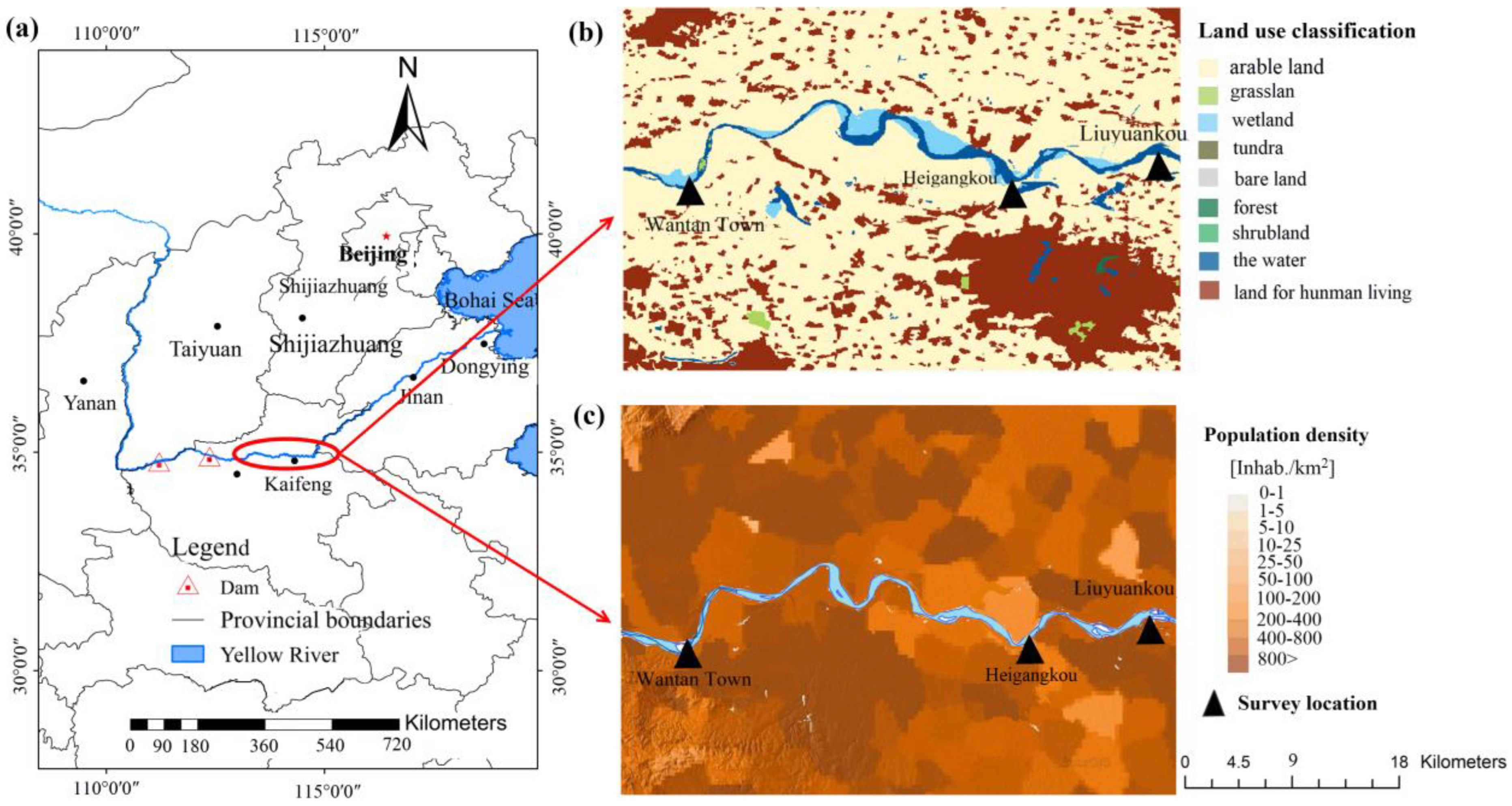
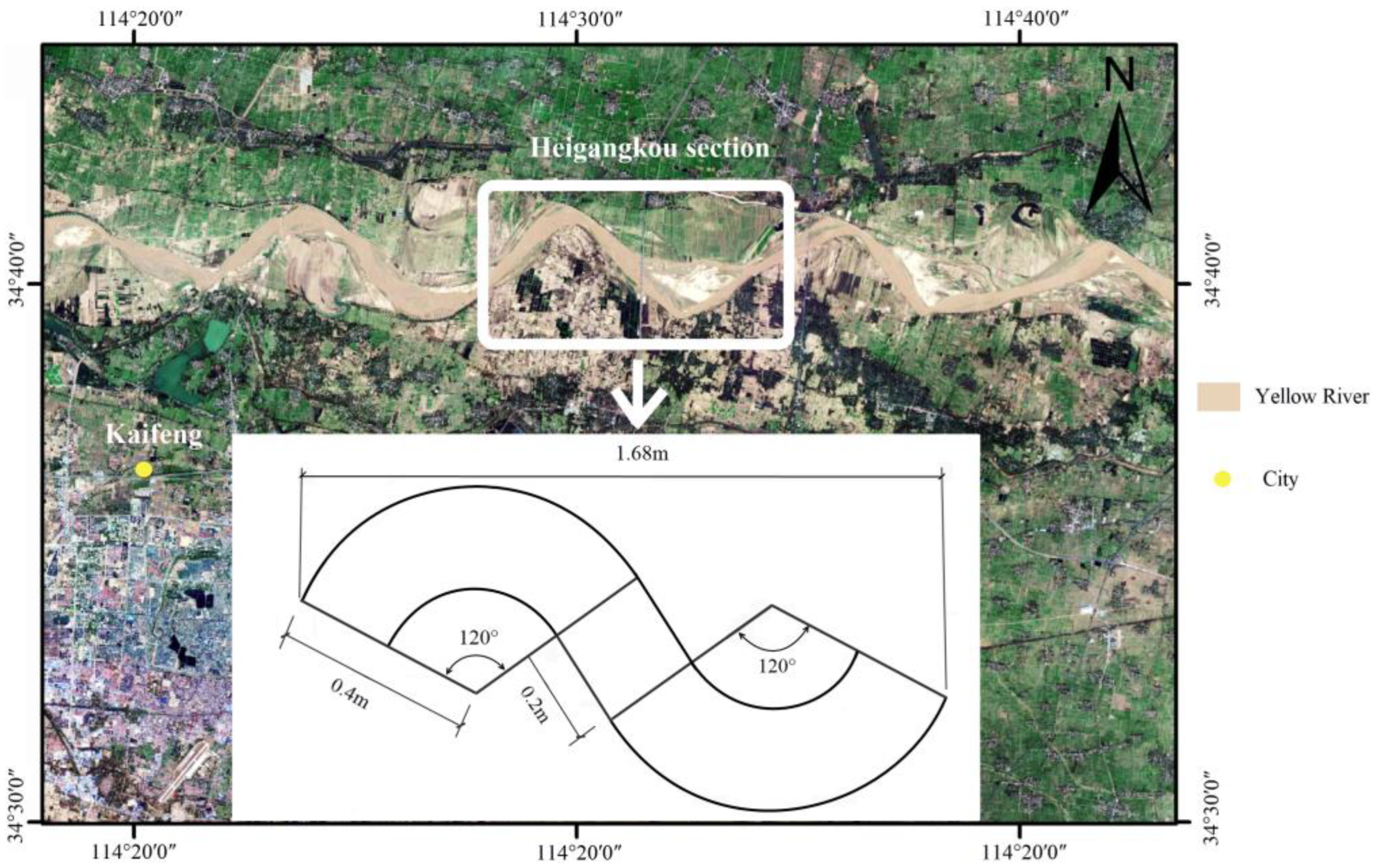


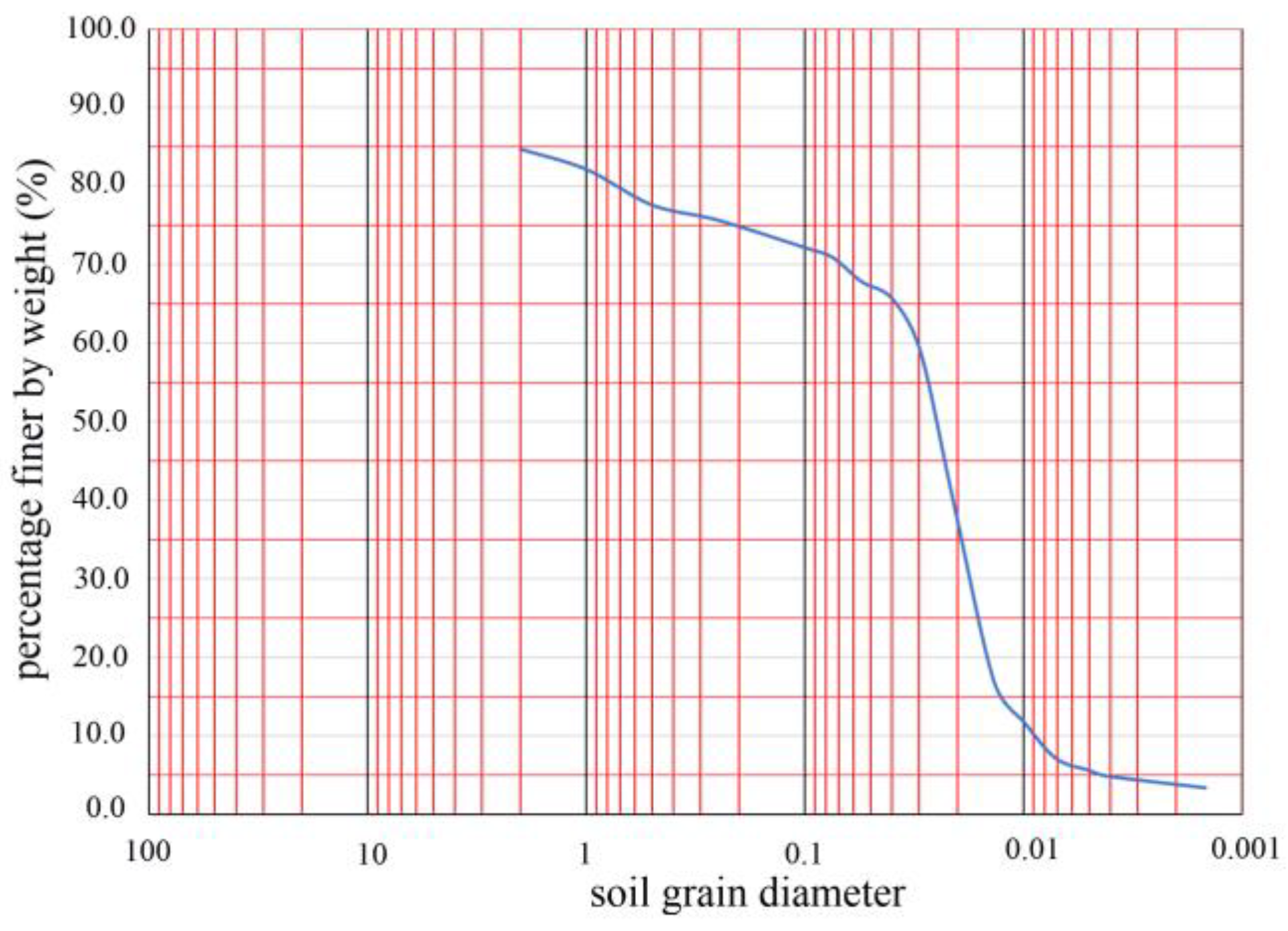
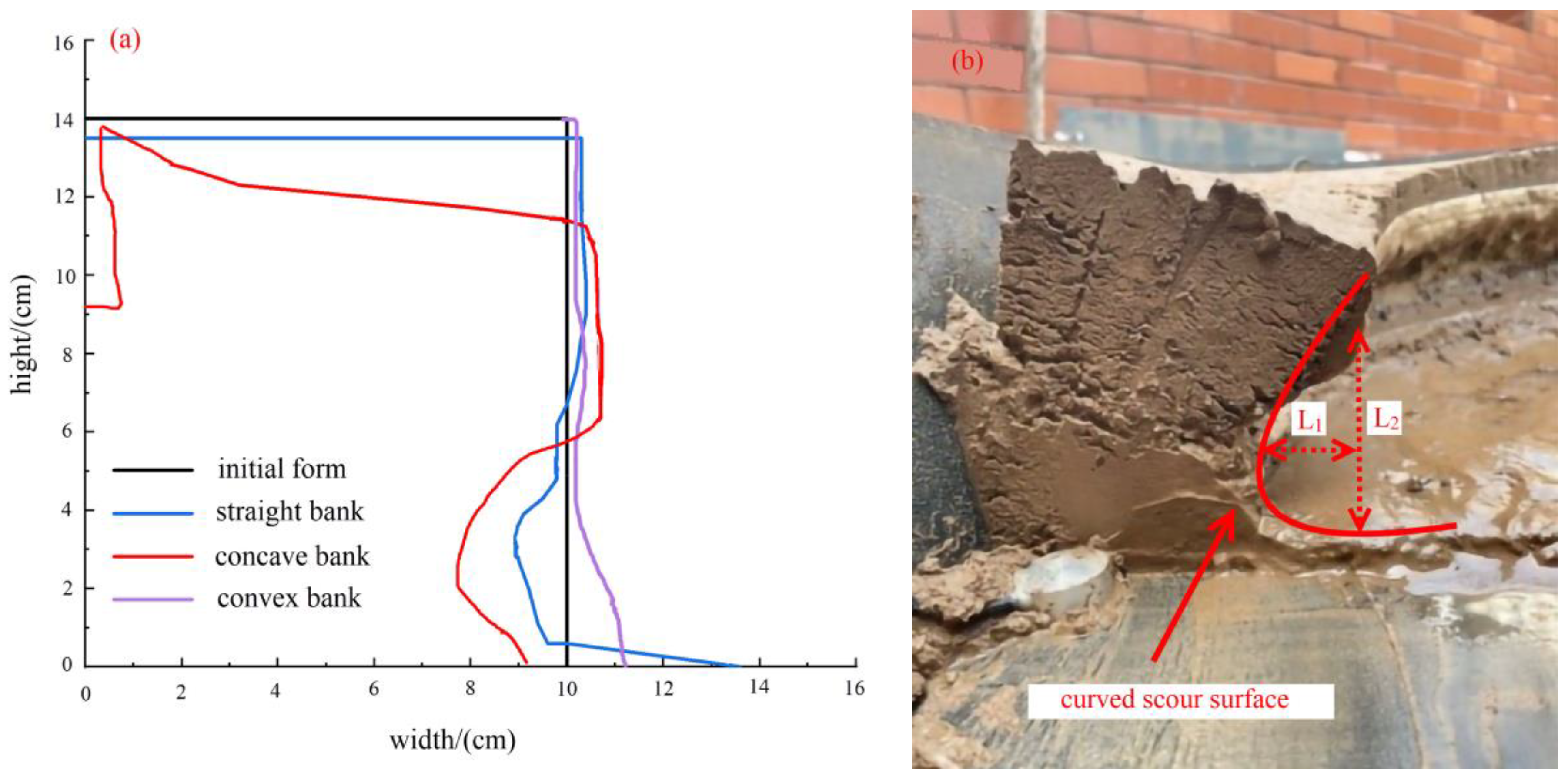
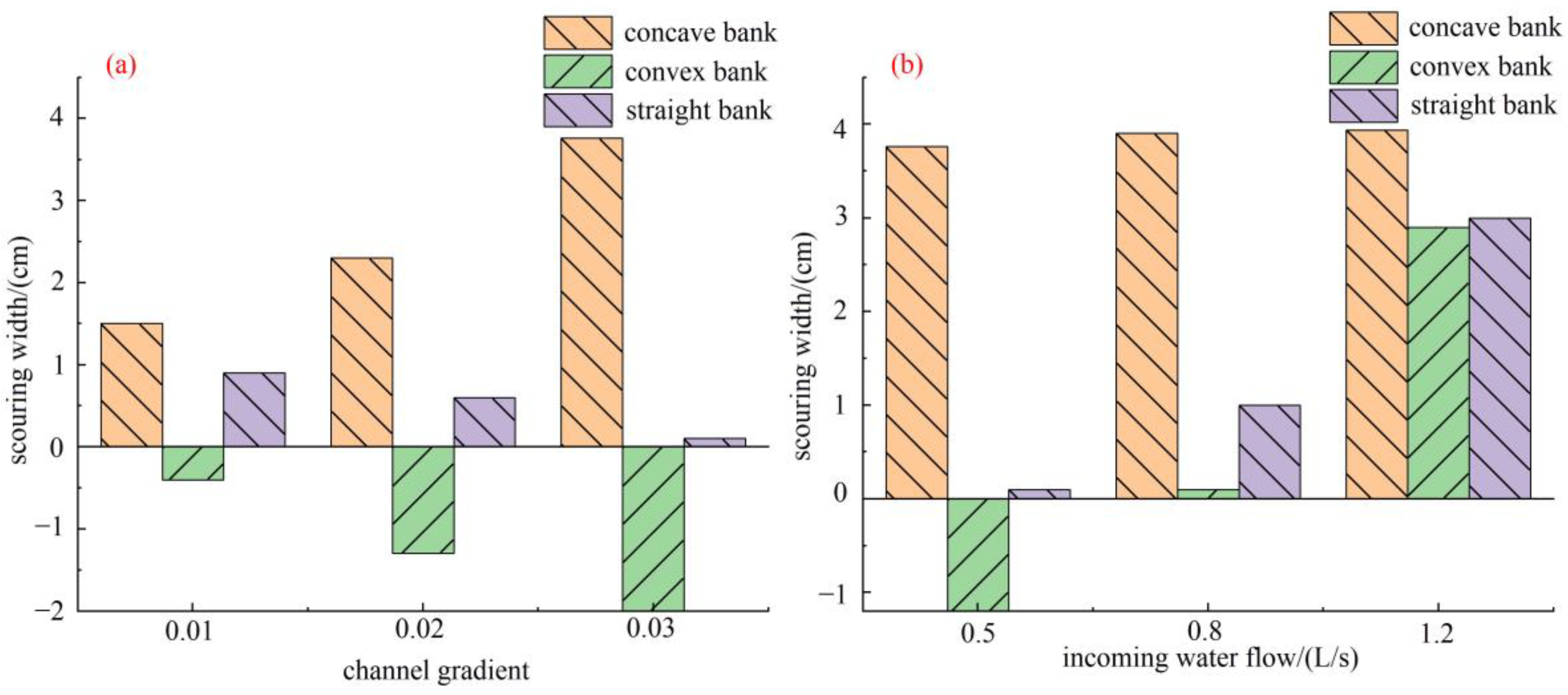
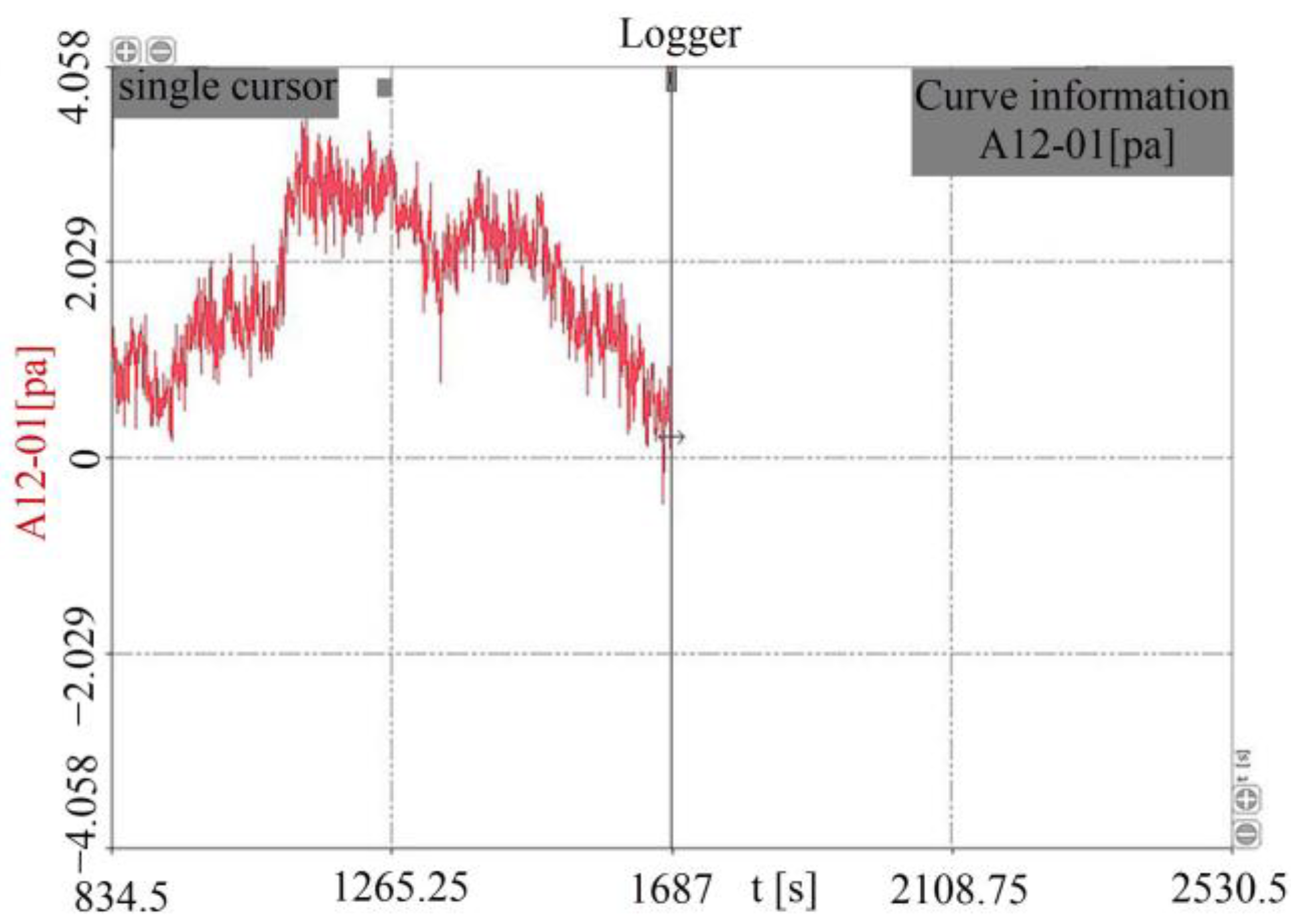
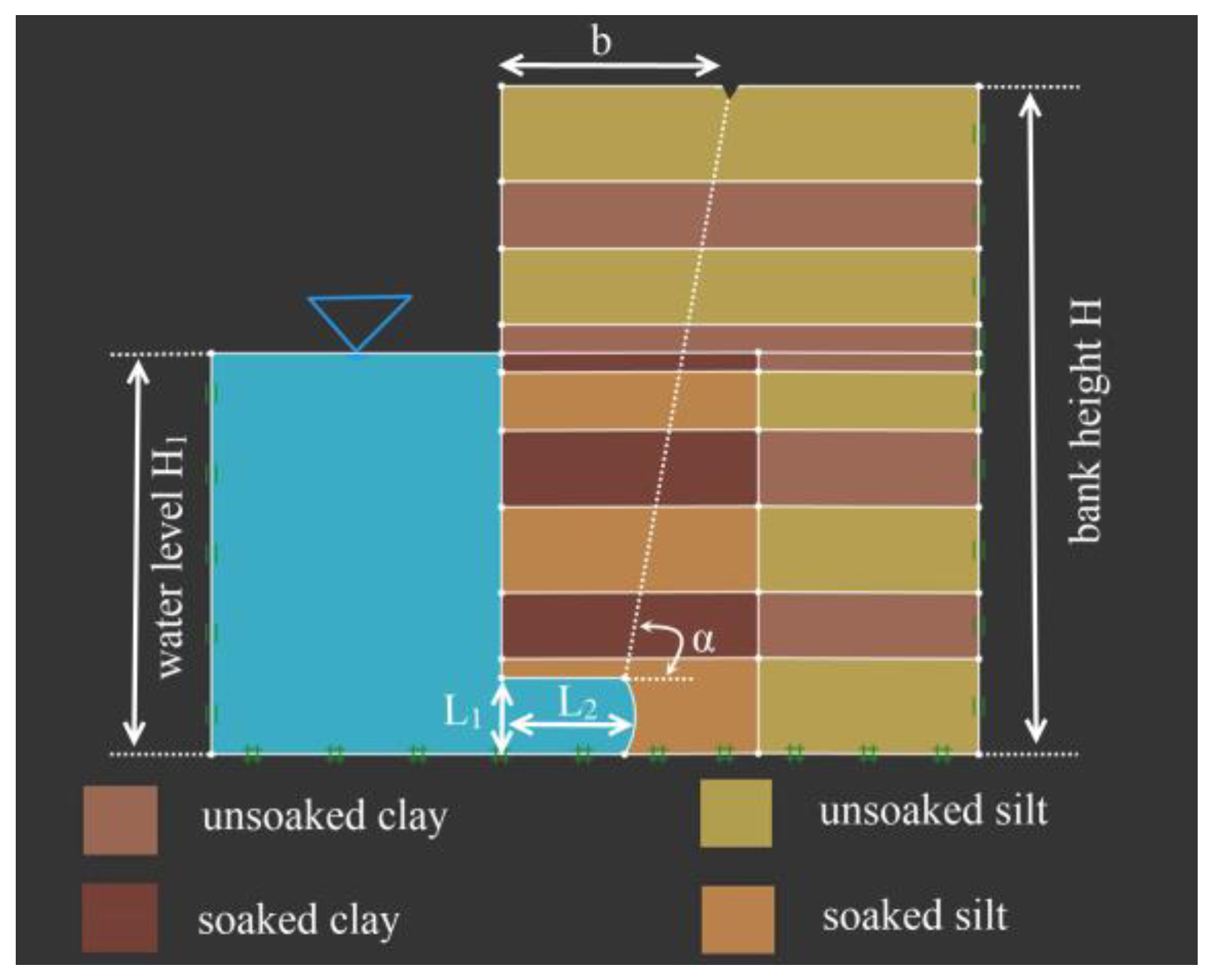
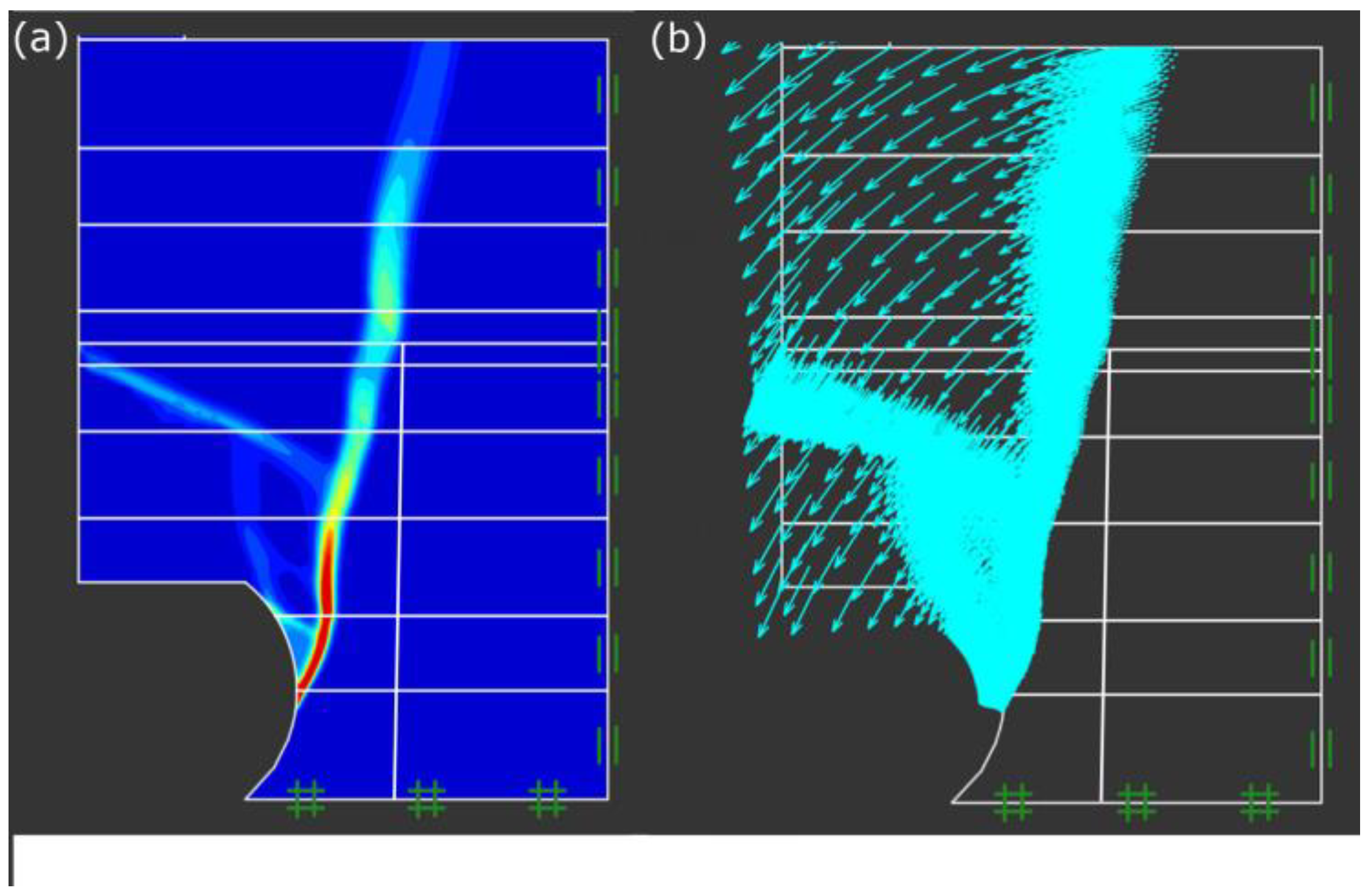
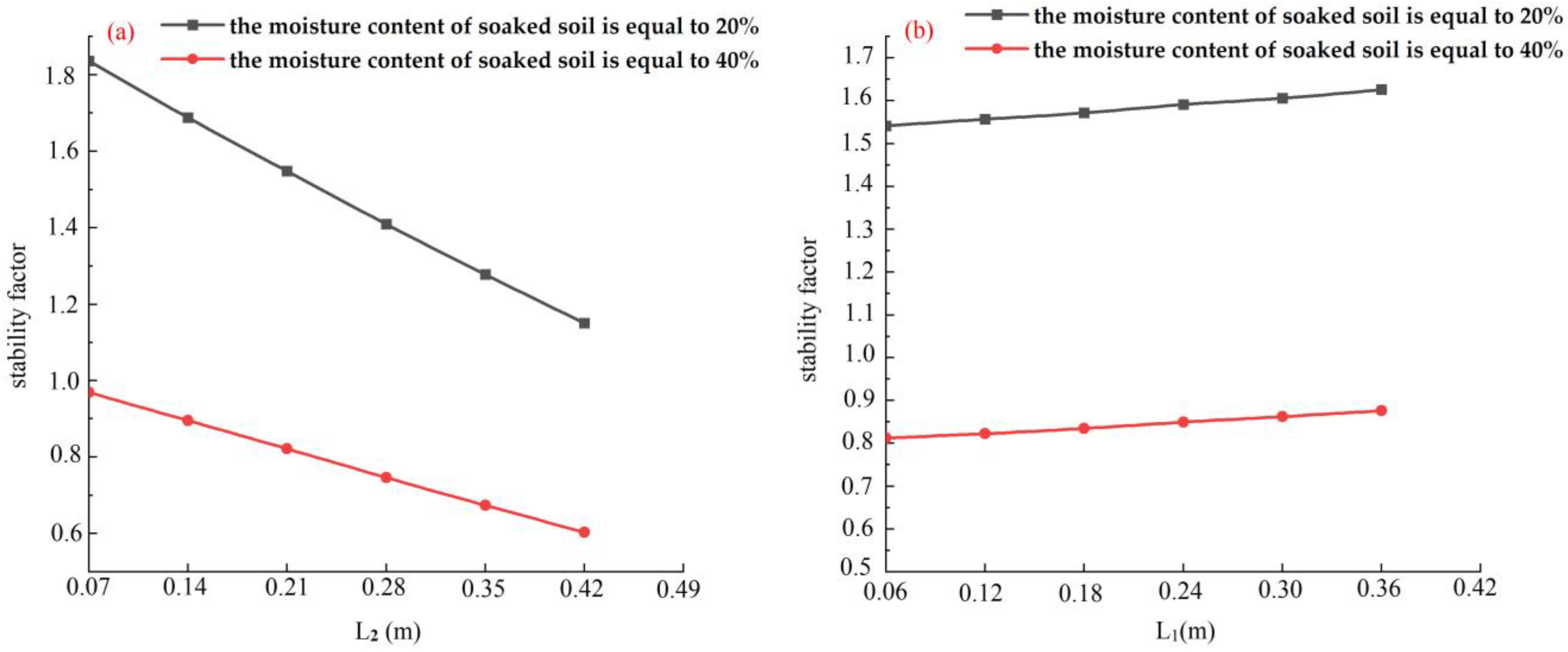


| Working Condition | Bank Height (cm) | Flow (L/s) | Bank Angle (°) | River Gradient | Scouring Time (h) |
|---|---|---|---|---|---|
| 1 | 14 | 0.5 | 90 | 0.01 | 1 |
| 2 | 14 | 0.5 | 90 | 0.02 | 1 |
| 3 | 14 | 0.5 | 90 | 0.03 | 1 |
| 4 | 14 | 0.8 | 90 | 0.01 | 1 |
| 5 | 14 | 1.2 | 90 | 0.01 | 1 |
| Soil Label | Sampling Location | Depth (cm) | Moisture Content (%) | Dry Density (g·cm−3) | Wet Density (g·cm−3) | Ip | Shear Strength | |
|---|---|---|---|---|---|---|---|---|
| C (kPa) | φ (°) | |||||||
| 1 | Wantantown | 25 | 21.15 | 1.66 | 2.009 | 18.2 | 36.5 | 28.6 |
| 2 | Wantantown | 86 | 35.61 | 1.40 | 1.851 | 23.6 | 26.36 | 18.56 |
| 3 | Heigangkou | 30 | 16.7 | 1.57 | 1.836 | 21.1 | 49.1 | 32.3 |
| 4 | Heigangkou | 55 | 25.55 | 1.71 | 2.113 | 19.4 | 31.3 | 26.5 |
| 5 | Liuyuankou | 93 | 28.81 | 1.63 | 2.232 | 21.7 | 39.1 | 23.63 |
| 6 | Liuyuankou | 137 | 39.71 | 1.49 | 1.910 | 18.8 | 36.51 | 25.1 |
| H (m) | H1 (m) | L1 (m) | L2 (m) | Moisture Content | Soil Type | C (kPa) | φ(°) | Dry Density (kN·m−3) | Wet Density (kN·m−3) |
|---|---|---|---|---|---|---|---|---|---|
| 1.4 | 1 | 0.39 | 0.29 | 20% | clay silty sand | 35 25 | 30 35 | 17 16 | 15 14 |
| 40% | clay silty sand | 15 10 | 10 20 | 18 17 | 15 14 |
| H (m) | H1 (m) | L1 (m) | L2 (m) | Moisture Content | Soil Type | C (kPa) | φ(°) | Dry Density (kN·m−3) | Wet Density (kN·m−3) |
|---|---|---|---|---|---|---|---|---|---|
| 1.4 | 0.6 H | / | / | 20% | clay silty sand | 35 25 | 30 35 | 17 16 | 15 14 |
| 40% | clay silty sand | 15 10 | 10 20 | 17 17 | 15 14 |
Disclaimer/Publisher’s Note: The statements, opinions and data contained in all publications are solely those of the individual author(s) and contributor(s) and not of MDPI and/or the editor(s). MDPI and/or the editor(s) disclaim responsibility for any injury to people or property resulting from any ideas, methods, instructions or products referred to in the content. |
© 2023 by the authors. Licensee MDPI, Basel, Switzerland. This article is an open access article distributed under the terms and conditions of the Creative Commons Attribution (CC BY) license (https://creativecommons.org/licenses/by/4.0/).
Share and Cite
Wang, H.; Hu, Q.; Liu, W.; Ma, L.; Lv, Z.; Qin, H.; Guo, J. Experimental and Numerical Calculation Study on the Slope Stability of the Yellow River Floodplain from Wantan Town to Liuyuankou. Toxics 2023, 11, 79. https://doi.org/10.3390/toxics11010079
Wang H, Hu Q, Liu W, Ma L, Lv Z, Qin H, Guo J. Experimental and Numerical Calculation Study on the Slope Stability of the Yellow River Floodplain from Wantan Town to Liuyuankou. Toxics. 2023; 11(1):79. https://doi.org/10.3390/toxics11010079
Chicago/Turabian StyleWang, Hao, Qing Hu, Weiwei Liu, Liqun Ma, Zhiying Lv, Hongyu Qin, and Jianbo Guo. 2023. "Experimental and Numerical Calculation Study on the Slope Stability of the Yellow River Floodplain from Wantan Town to Liuyuankou" Toxics 11, no. 1: 79. https://doi.org/10.3390/toxics11010079






